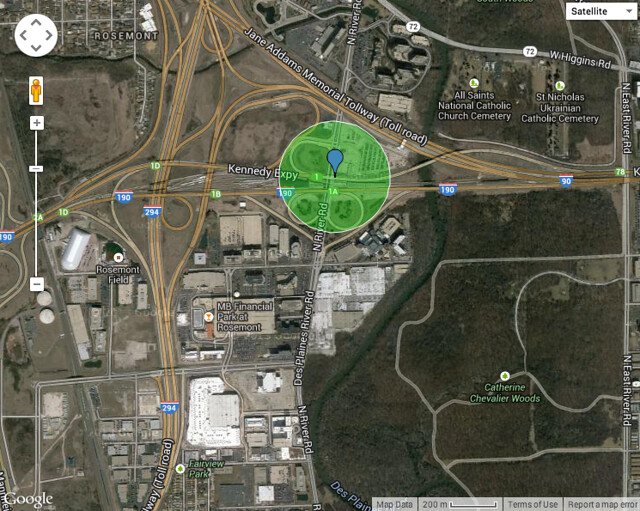
The northwest suburban village of Rosemont has always been divided by busy transportation routes that funnel people through a crossroads. Occupying the geographic center of the town is a giant interchange, where the Kennedy Expressway, the Jane Addams (Northwest) Tollway, the Tri-State Tollway, and the I-190 spur to O'Hare Airport tangle over 300 acres of land -- an area larger than Grant Park and Millennium Park combined. Overhead, a steady stream of jets roar into O'Hare. CTA Blue Line trains roll down the Kennedy's median, toward the airport or a CTA facility within the interchange.
Yet transportation is also what makes Rosemont tick. Those busy routes deliver up to 100,000 visitors a day to a village of just 4,202. Many go to work in the village's 5.2 million square feet of high-rise offices, convenient to commuters from all four directions. Others come to sleep in its 15 airport-adjacent hotels. Still others attend events at the village's convention center or arena, or join the merrymakers on their way to the town's newest commercial attractions -- the Fashion Outlets of Chicago shopping mall and MB Financial Park at Rosemont, an entertainment district housing an 18-screen cinema and 200,000 square feet of restaurants and bars.
All of this development might look impressive to passengers on airplanes flying into O'Hare, or for motorists speeding by on the Tri-State -- but it's far from appealing when approached on foot from the 'L' station. A forthcoming planning study, funded by the Regional Transportation Authority and the federal government, could change that. The study will examine access to the 'L' station and ponder the potential to develop the adjacent bus facility and parking lot.
The nearly two million 'L' passengers who arrived at Rosemont last year all stepped out from the station and into a parking lot in the middle of a cloverleaf interchange. Not only does any walk from that point require leapfrogging highways and on-ramps, but the walks are long: Five minutes from the platform doesn't even get a pedestrian past the edge of the cloverleaf.

To reach even the nearest building to the station, the Hyatt Regency O'Hare hotel, requires a nine-minute walk that winds halfway around the hotel. The hotel's long driveway and blocky geometry make for a sweeping view when approaching by car -- it may have looked futuristic back in 1969, when the hotel and the jet-age airport and the tollways were all brand-new.
More recent developments don't seem to have incorporated many lessons from the past. Even Rosemont's "urban" park, ringed with outdoor cafes and programmed non-stop with activities from summer concerts to ice skating, is a 22-minute walk from the 'L' station, and faces the Tri-State Tollway. Most local patrons drive there, and its Yelp reviews mostly focus on its confusing parking garage. At the brand-new mall across the street, all of the entrances open onto garages.
Instead of walking, many passengers today board one of the many shuttle buses that can be found idling in the 'L' station's parking lot en route to local offices or amusements. A generation ago, already recognizing the hostile pedestrian environment around the then-new station, RTA funded studies into a "personal rapid transit" automated people-mover that would have whisked people over the parking lots and highways and right into local buildings, somewhat like the system that shuffles around downtown Detroit.
Although that costly system was never built, the new plan will start to address the same problem using simpler technologies, like walking. The plan will examine all elements of the station experience, from needed renovations within the 31-year-old station, to appropriate land uses for the parking lot just outside, to strategies that will better connect the station to the village beyond. The plan will "help to provide improvements and add value to the area for residents and commuters while encouraging local development," said RTA Acting Executive Director Leanne Redden in a statement.
Mayor Brad Stephens, son of the village's founder and longtime mayor Donald Stephens, welcomed the news, saying in a statement, "We know how important transit is to our continued growth... We're glad the RTA is making this stop a priority in its future planning."
The plan will also take into account the Rosemont station's role as one of the largest multimodal transfer points between CTA rail and suburban buses, one that's growing this year as Pace launches express bus service along the Jane Addams Tollway. If that service eventually matures into bus rapid transit for the northwest suburbs, the Rosemont plan could help build an understanding of how to better link expressway transit corridors to adjacent development.
The $250,000 plan will be covered by $200,000 in federal funds and $50,000 from RTA's community planning program, and also happens to coincide with a CMAP project to update the village's comprehensive plan. It is one of ten Community Planning projects that RTA is undertaking this year, including $120,000 for two other transit-oriented development studies in Geneva and Melrose Park.




